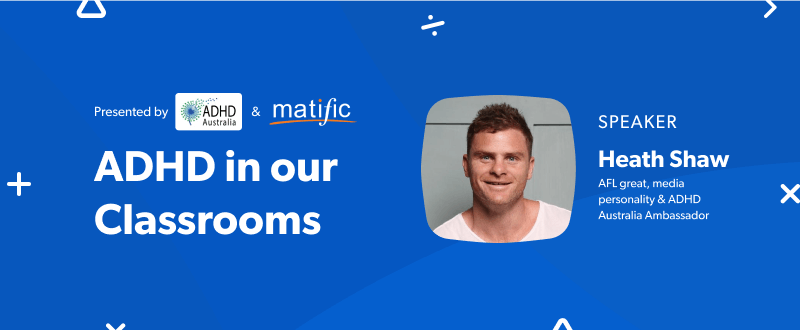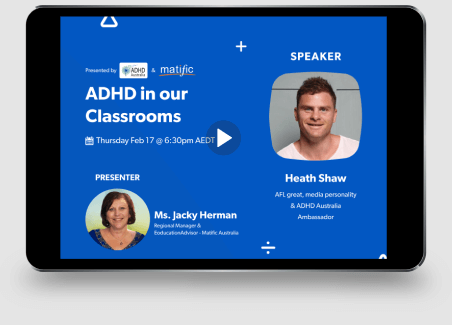
A Conversation with Heath Shaw, AFL Star ADHD Story
Do you have children with ADHD in your classroom? As many as 1 in 20 Australians have Attention deficit hyperactivity disorder or ADHD. Other research shows that ADHD may affect up to 9% of the population. For teachers, this means that as many as 2 or 3 students in their classroom may have ADHD.
To learn more about this condition, Matific recently hosted a webinar featuring Australian football star Heath Shaw, and ADHD Australia leaders Duncan Brown and Terri Martin. Discover some of the important points covered in the webinar below:
What is ADHD?
ADHD affects executive functioning. This means that people with ADHD have trouble self-regulating and controlling their thoughts, words, emotions, and actions. Some struggles with executive function mean people with ADHD struggle to manage time or navigate social situations. Emotional maturity may also lag behind. For example, a child who is in year 6 may have the emotional maturity of a child in year 4. Another hallmark sign of ADHD is that students may work very well one day, and struggle the next for no apparent reason.
Both boys and girls can have ADHD, although almost twice as many boys are diagnosed with the disorder as girls. Yet, some research shows that girls and women are underdiagnosed with ADHD, as their symptoms are often downplayed or more subtle. For example, girls may be more talkative rather than running around the classroom.
Despite these differences, ADHD also offers advantages. People with ADHD are often capable of hyper-focusing on areas of interest. Another benefit is tremendous creativity, energy, and enthusiasm.
It’s also important to highlight that ADHD is related to biological and anatomical differences in the brain.
Heath Shaw’s ADHD Experience
AFL star Heath Shaw was diagnosed with ADHD in Year 8 after experiencing learning and behavioral issues. Shaw is also an Ambassador for ADHD Australia. About his role, he says “When I was younger, it wasn’t prominent, ADHD wasn’t talked about as much. When the opportunity came with ADHD Australia to spread more awareness about this, I wanted to share my stories and experience.”
As a child, Shaw’s teachers noticed that he sometimes struggled to concentrate and also had trouble with impulse control. One thing he recalls is throwing erasers in class. Yet, he says he had a hard time explaining to the teacher why he did this. “It was almost as if it was instinct,” he said. “There was no reason.”
Between his teachers and his mother, Shaw finally got diagnosed in year 8. Although his mother wasn’t keen on medication, he did use medicine through year 12. He says that it did help him a lot even though there were still many ups and downs. Many teachers were very supportive of his diagnosis. In particular, one teacher would often ask him how he was feeling. When he wasn’t ready to concentrate and be in class, the teacher would allow him to go to the library to study. This worked out for both of them as Shaw didn’t disrupt class and he was also able to focus on something else.
Shaw notes that he never had trouble with ADHD symptoms while at football practice or on the field. It was one part of his life that gave him routine and allowed him to excel.
Shaw’s Advice for Teachers
Shaw sympathizes with teachers, who “have a tough gig.” He encourages teachers to try to work with students with ADHD and to open a dialogue with them. For instance, you might ask “What can I do to help?” he says. This can help support students, as ADHD kids aren’t trying to be naughty, he says.
What to Do if You Suspect Your Student Has ADHD
It’s important to take steps to help students who may have ADHD. Here are some helpful steps to take.
- Meet with parents to share your observations about the student’s behavior (Do not mention ADHD at this stage). Recommend eyesight and hearing checks to rule out other reasons for behaviors.
- Discuss your concerns with your assistant principal/school counselor. Class and playground observations should be recorded. Without letting the student know, sit quietly to observe their behavior.
- Hold a follow-up meeting with the parents. The AP and/or counselor may attend to discuss the results of the eyesight and hearing checks.
- If appropriate, recommend an appointment with the pediatrician.
Other Ways to Support Students with ADHD
Some practical steps can be taken to support students with an ADHD diagnosis. Here are some things you can do:
- Allow fidgeting toys/supports. These can help students focus.
- Support the self-esteem of these students. Children with ADHD have a higher incidence of depression.
- Make accommodations such as longer test times, have someone read the questions out loud, etc.
- Use gamification through apps like Matific that help motivate students with ADHD with intrinsic motivation.
If you’re a teacher, chances are you’ll encounter children in your classroom with ADHD. Taking the time to understand and support these students will go a long way to helping them succeed and creating a positive learning environment in your classroom.
Are you ready to learn more? We encourage you to watch the full webinar and to get in touch with our team so you can be aware of future professional development opportunities.
Watch Full Video
